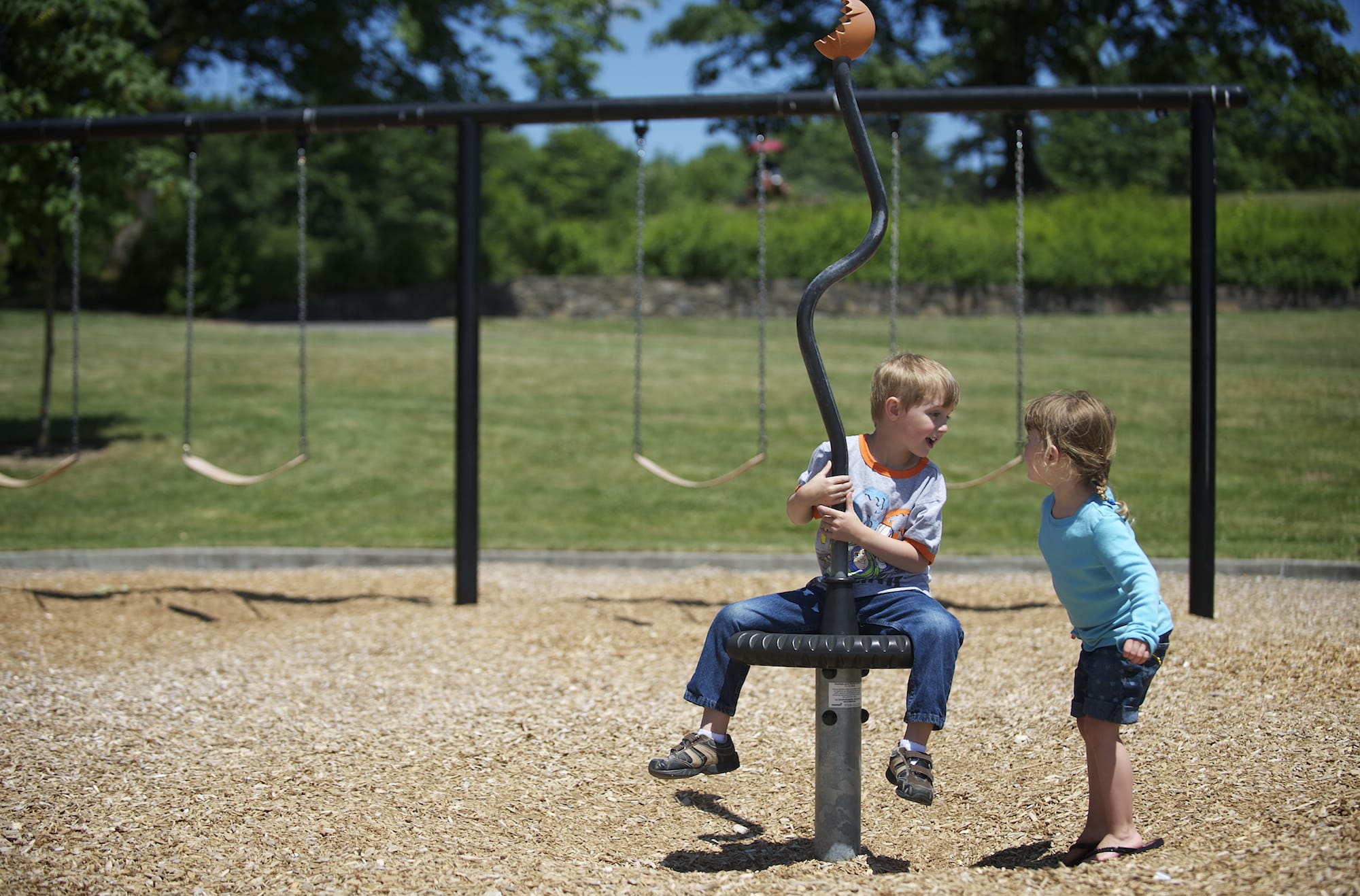Looking to check out play equipment you haven’t tried before? Here are a few parks to consider:
Big structures: Marshall Park, 1015 E. McLoughlin, Vancouver.
Climbing: Vista Meadows Neighborhood Park, Northeast 29th Avenue at 145th Street, Vancouver.
Challenging: Sgt. Brad Crawford Neighborhood Park, 4710 N.W. 131st St., Vancouver.
Modern: Gretchen Fraser Neighborhood Park, Mill Plain Boulevard at 155th Avenue, next to Vancouver’s East Precinct police station.
Accessible: LeRoy Haagen Memorial Park, Northeast Ninth Street west of 136th Avenue, Vancouver.
Anyone who thinks playground equipment is all fun and games should peruse the Consumer Products Safety Commission’s 57-page handbook on playground safety.
It’s an exhaustive rundown, complete with diagrams: Openings in guardrails and between ladder rungs shouldn’t measure less than three-and-a-half inches or more than 9 inches. Surfaces around playground equipment should be covered by at least 12 inches of wood chips or other soft material. No bolts should protrude from the structure.
Looking to check out play equipment you haven't tried before? Here are a few parks to consider:
Big structures: Marshall Park, 1015 E. McLoughlin, Vancouver.
Climbing: Vista Meadows Neighborhood Park, Northeast 29th Avenue at 145th Street, Vancouver.
Challenging: Sgt. Brad Crawford Neighborhood Park, 4710 N.W. 131st St., Vancouver.
Modern: Gretchen Fraser Neighborhood Park, Mill Plain Boulevard at 155th Avenue, next to Vancouver's East Precinct police station.
Accessible: LeRoy Haagen Memorial Park, Northeast Ninth Street west of 136th Avenue, Vancouver.
That’s a big change from when today’s parents were kids.
“Our childhood memories are of a jungle gym on asphalt,” said Terry Snyder, who designs parks for the city of Vancouver. He began his parks career in the early 1980s, just as attitudes toward playgrounds were shifting. “A lot of the changes that have occurred have dealt with safety issues,” Snyder said.
Playground architects are attempting to return some of the elements of challenge and movement — and just plain fun — that were lost as equipment became safer. Good thing, given that experts say activities such as climbing, swinging and spinning are key to child development.
‘Sand gardens’
The first playgrounds date back to the mid-1800s, with the origination of “sand gardens” in Europe. They reached Boston in 1886, launching the American playground movement.
The sand gardens evolved over the decades into playgrounds of free-standing structures, such as monkey bars, swings, seesaws, merry-go-rounds and slides.
Lawsuits from parents whose children were injured at playgrounds led to a more safety-minded approach to design, with planners more closely heeding the Consumer Products Safety Commission handbook on playground safety, first published in 1981.
“We got very stagnant playgrounds. Nothing moved,” Snyder said. That’s beginning to change, he said, as playground companies pick up on styles of equipment found in Europe.
That’s something Doug Buell, owner of Buell Recreation in Portland, also has noticed. His company sells commercial play equipment.
“Europe has a quite a different approach, a lot freer,” Buell said. “We’ve integrated a lot of safety into the play environment, and manufacturers’ hands are tied.”
In the past decade or so, playgrounds are inviting a greater range of physicality, “more than climbing steps and going down a slide,” Buell said.
“Older kids are going to want to be challenged,” said Steve Kirn, sales manager at Columbia Cascade Co., a Portland company with a fabrication plant in Vancouver. “We want to give them something that has an element of risk but not hazard.”
Focus on longevity
Around Vancouver, you’ll find climbing walls and webs, balance beams and inscrutable structures of elegantly curved metal pipe. Merry-go-rounds might have gone out of fashion, but new kinds of spinners give kids a chance to whirl around until they’re dizzy.
Equipment for a playground costs about $40,000, with another $15,000 to install it and lay some sort of soft surfacing on the ground, Snyder said.
Vancouver tries to get 25 years out of a piece of playground equipment, so “we try to pick equipment that has longevity to it,” he said.
When replacing equipment and revamping a playground, the city also increases accessibly for children of all abilities, as well as their parents, by removing the curbing that holds in the bark chips to soften falls or adding ramps, Snyder said.
When he’s shopping for equipment, Snyder looks for a measure of challenge for children of different ages, a sense of height, as well as opportunities to build upper body strength and balance.
Time at the playground is essential for children, said Joy Kinkaid, a pediatric occupational therapist. She and her colleagues at Legacy Salmon Creek Medical Center encourage their patients to go to parks and play.
“We think that parks are just a great places to develop gross motor skills,” Kinkaid.
Climbing helps build muscles, Kinkaid said. Swings help children develop a sense of gravity. Moving bridges and narrow beams give children a chance to practice balance. Different types of play can also help children regulate their energy levels. Slow swinging soothes and calms children, while spinning revs them up.
A break at the park to climb or traverse the monkey bars — activity that occupational therapists categorize as “heavy work” — can prepare a kid to focus.
“Kids need to move in different ways,” Kinkaid said. “That’s how children learn and develop — through play.”



